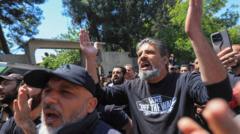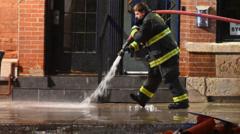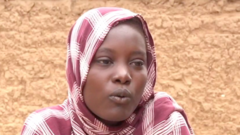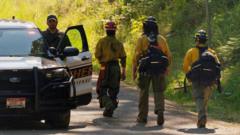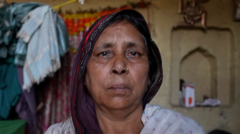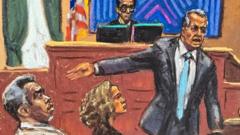In the aftermath of Syria's devastating civil war, a team of medical professionals at the Syrian Identification Centre in Damascus faces a daunting task as they attempt to identify the remains found in mass graves. These efforts are challenged by limited resources, sanctions, and the sheer scale of the tragedy, which has left hundreds of thousands dead or missing.
Long Road to Justice: Medical Team Tasked with Identifying Syria's Mass Graves
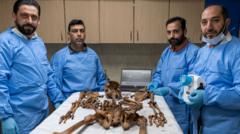
Long Road to Justice: Medical Team Tasked with Identifying Syria's Mass Graves
A newly established Identification Centre in Damascus struggles to identify the remains from mixed mass graves, a task hindered by years of civil war devastation and ongoing sanctions.
In the basement of a modest building in Damascus, Dr. Anas al-Hourani, head of the Syrian Identification Centre, stands among tables meticulously arranged with human femurs. "These are from a mixed mass grave," he states, signaling the beginning of a complex process required to identify remains that may belong to some of the hundreds of thousands killed during the 13-year civil war under the regime of Bashar al-Assad and his father, Hafez.
With a mix of sorrow and resolve, Dr. al-Hourani explains that the ongoing conflict created such mass graves—a situation where the deceased are carelessly piled one atop another. Many of the bones currently being processed may belong to recent victims, but identifying them is fraught with obstacles. "It can take months to identify just one victim from a mixed mass grave," he reveals, emphasizing the lengthy work ahead, which he estimates will take years.
Examining the bones can yield important clues; through forensic odontology, information about victims’ height, sex, age, and potential career can emerge, alongside evidence of possible torture. However, the lab's reliance on tests for DNA identification encounters practical barriers, including the existence of a single functional DNA testing center in Syria, loss of essential equipment to war damage, and sanctions limiting the availability of required chemicals. Compounding these issues, the average cost for a full DNA test can reach $250, making thorough investigations unmanageable amidst widespread financial constraints.
As the new Islamist-led government claims a commitment to "transitional justice," many families, who have lost relatives and are still seeking answers about disappeared loved ones, express frustration over the perceived lack of action. Reports suggest over 130,000 individuals were forcibly disappeared during the conflict, leaving many families in a state of deep despair.
On a hillside outside Damascus lie eleven visible mass graves, remnants of the atrocities carried out during the war. Accompanied by Hussein Alawi al-Manfi, a former military driver, the BBC reports firsthand accounts of the horrors witnessed by those who transported bodies to these burial sites. Abu Ali, the driver, emotionally recounts his role in the macabre operation, having transported loads of civilian corpses routinely for over a decade, describing them as "mangled and tortured." Each lorry would often contain as many as 200 bodies, and Abu Ali recalls the routine of unloading them into trenches, a sight that weighed heavily on his conscience.
Meanwhile, the personal toll of the war is evident in the story of Malak Aoude, a mother who still grieves for her two sons, both of whom were disappeared under the oppressive regime. Returning to Syria after years as a refugee, she continues to seek answers about what happened to her boys, painfully recounting their stories of detention and presumed death.
As the identification efforts unfold in Syria, hope for closure remains entwined with grief, as victims’ families await the justice that has been long promised but remains frustratingly elusive.
With a mix of sorrow and resolve, Dr. al-Hourani explains that the ongoing conflict created such mass graves—a situation where the deceased are carelessly piled one atop another. Many of the bones currently being processed may belong to recent victims, but identifying them is fraught with obstacles. "It can take months to identify just one victim from a mixed mass grave," he reveals, emphasizing the lengthy work ahead, which he estimates will take years.
Examining the bones can yield important clues; through forensic odontology, information about victims’ height, sex, age, and potential career can emerge, alongside evidence of possible torture. However, the lab's reliance on tests for DNA identification encounters practical barriers, including the existence of a single functional DNA testing center in Syria, loss of essential equipment to war damage, and sanctions limiting the availability of required chemicals. Compounding these issues, the average cost for a full DNA test can reach $250, making thorough investigations unmanageable amidst widespread financial constraints.
As the new Islamist-led government claims a commitment to "transitional justice," many families, who have lost relatives and are still seeking answers about disappeared loved ones, express frustration over the perceived lack of action. Reports suggest over 130,000 individuals were forcibly disappeared during the conflict, leaving many families in a state of deep despair.
On a hillside outside Damascus lie eleven visible mass graves, remnants of the atrocities carried out during the war. Accompanied by Hussein Alawi al-Manfi, a former military driver, the BBC reports firsthand accounts of the horrors witnessed by those who transported bodies to these burial sites. Abu Ali, the driver, emotionally recounts his role in the macabre operation, having transported loads of civilian corpses routinely for over a decade, describing them as "mangled and tortured." Each lorry would often contain as many as 200 bodies, and Abu Ali recalls the routine of unloading them into trenches, a sight that weighed heavily on his conscience.
Meanwhile, the personal toll of the war is evident in the story of Malak Aoude, a mother who still grieves for her two sons, both of whom were disappeared under the oppressive regime. Returning to Syria after years as a refugee, she continues to seek answers about what happened to her boys, painfully recounting their stories of detention and presumed death.
As the identification efforts unfold in Syria, hope for closure remains entwined with grief, as victims’ families await the justice that has been long promised but remains frustratingly elusive.


